#cut a little opening and place either the soup or eggs meat and cheese inside
Text
My Top 17 Foods To Eat In Chengdu
Szechuan cold spicy noodles 四川涼面
These are hands down my favourite food to get in Chengdu. Sitting down in the heat outside with some cold spicy noodles (and a beer - of course) is the best way to spend a hot summers day here. It’s a great mixture of garlic, spring onions, ginger, and lots of chilli oil. I think I prefer cold noodles over hot noodles because it takes the heat down a level. Just writing about these noodles is making me want to go for a walk down to the noodle joint near our complex! An absolute staple of Szechuan cuisine - 10/10!

Steamed buns 包子
Steamed buns, or baozi, kept me alive when we first arrived in Chengdu and were running round trying to get all our documents sorted. They’re so convenient and you can really get them everywhere. I love the snacking culture here in China because it means you’re never very far away from some tasty street food. Steamed buns, sweet or savoury, never break the bank and you can pick one up normally for around 20p/30p. Steamed pork buns are my favourite bun but it’s always fun to try new ones - like the custard buns that you can poke with a chopstick and squeeze all the custard out… granted it can look a little disturbing but it’s still fun!

Dumplings in chilli sauce 红油抄手
Another classic here. I wasn’t a huge fan of these the first time I tried them but now I can’t get enough of them. I think I’ve really worked up my heat tolerance since moving here and now there’s nothing better to me than a big bowl of pork dumplings covered in spicy chilli sauce! It’s the intensely aromatic sauce they’re coated with, made with vinegar, garlic, and roasted chilli oil, that makes these dumplings so irresistible. You can also get dumplings in soup but I prefer the dry dumplings with chilli sauce.
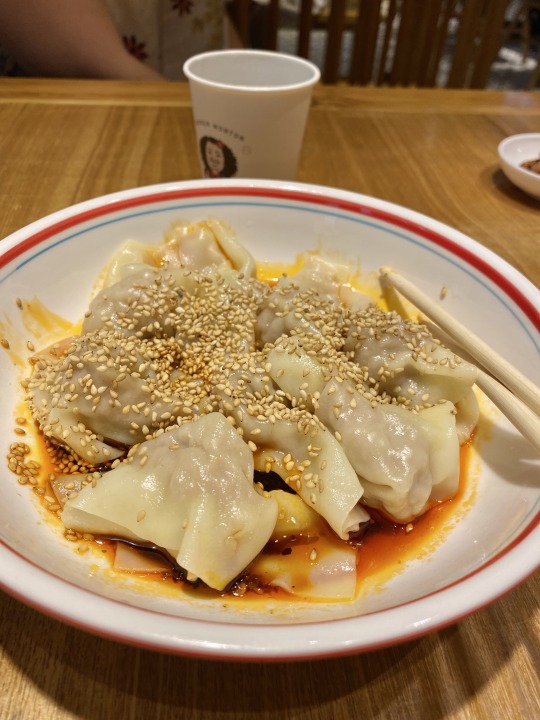
There are lots of different types of dumplings in Sichuan and China as a whole, but Zhong dumplings are named for the family who first made these in Chengdu around 100 years ago - and now they’re recognised officially as one of Szechuan’s most famous street foods! They’re a simple dumpling with sweet soy sauce and chilli oil and they’re great for beginners. James and myself were actually lucky enough to get to go on a dumpling making course when we first arrived - it was really fun!

Roast pork 烤猪肉
This isn’t a Szechuan specialty but it’s still very much available here in Chengdu. My favourite way of eating pork here so far has been where the pork is served on a sizzling plate with a sweet sauce and peanuts. Normally the server will pour the hot sauce over the pork in front of you and it’s great to watch it sizzle. I love it when meals feel more interactive like that. It’s super sticky and sweet and is everything that roast pork should really be!
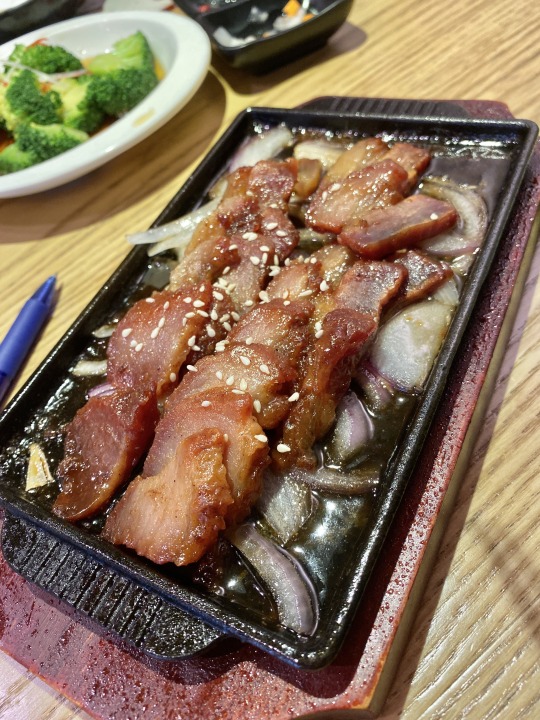
Hotpot 火锅
I think it would be a sin to come to Szechuan and not try hotpot at least once. Unfortunately, I’m not the biggest fan of hotpot with red oil but I do quite like the version of hotpot at a restaurant near us that uses what I think is some kind of chicken stock/soup to boil the ingredients. This restaurant is Hong Kong themed so it’s not typical Szechuan food. When the food is cooked you dip it in a sauce that you can put together yourself - this is chillis, garlic, soy sauce, and spring onions. There are a few different types of hotpot but some of the most popular here are chuan chuan 串串 (where you get your food on long sticks and place it in the pot) and huo guo 火锅 (where you place the food directly into the pot and scoop it out when it’s ready).

It’s a really fun way to eat though because at most restaurants you start by going around a fridge section of the restaurant with a basket and get to choose what you’d like to boil, then take it back to your table and cook it in the pot with your friends. Chinese style eating is quite different to the UK because typically you share food more instead of ordering just for yourself and I really prefer it like that - it just means you get to try more things and don’t have to worry about ordering something you won’t like! It’s a much more sociable way of dining and it’s just so much more fun.
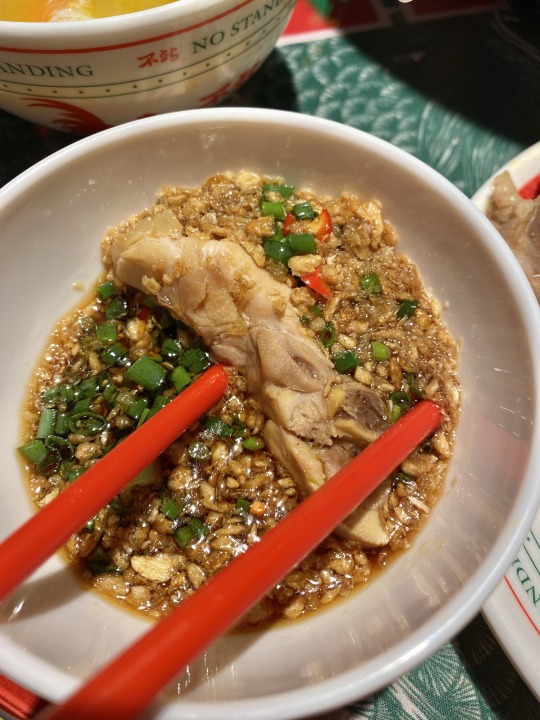
Eating with friends
It’s always so much more fun to share your cooking with your friends - especially when you all come from different parts of the world. I really love the other teachers in my class and so I decided to cook them some ‘traditional British food’ because Tina, one of the teachers, really loves trying new food. It was also a bit of a thank you for how welcoming they’d been and how much easier the job is working in our team. Of course, being the welcoming people they always are, they came to the dinner with Szechuan food for us to try too! They made us kung pow chicken, fried chicken wings, and mapo dofu (silken tofu in a spicy sauce) and we shared with them a cottage pie, potato and broccoli soup, Hellmann’s egg mayonnaise sandwiches, biscuits with brie, and a steamed syrup pudding - the best of both worlds!

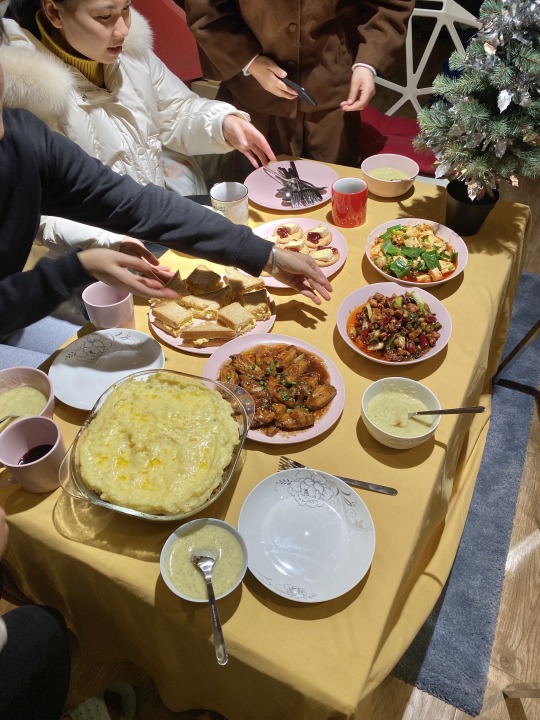
Dan dan mian 担担面
Dan dan mian (noodles) are so called because historically the walking street vendors who sold the dish would have a type of carrying pole (dan dan) that they carried over their shoulder with two baskets containing the noodles and sauce at either end. The name of these noodles is literally translated to noodles carried on a pole. They’re another Szechuan staple food and one of my favourite things to pick up when I’m walking around Chengdu. They're served hot with minced pork in a spicy sauce. They’re also served with preserved vegetables like zha cai 榨菜 (lower enlarged mustard stems) and ya cai 芽菜 (upper mustard stems). Living in Chengdu has meant that I’m a lot more into preserved vegetables than I was in the UK!
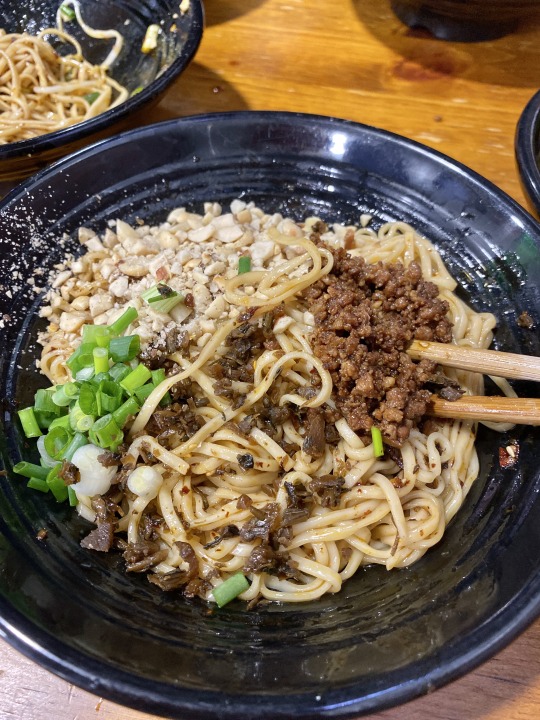

Xiaolongbao 小笼包
Now this is definitely not a Szechuan food but you can still get it in some places in Chengdu. It’s associated with Wuxi and Shanghai so I’m really excited to try some more when we move cities! It is a steamed dumpling with broth inside that's typically made from chicken or pork. You eat them using a soup spoon and a pair of chopsticks and bite into the dumpling on the spoon then suck out the soup. There’s a restaurant called ‘Modern China’ that we’ve been to a fair few times. It’s got a huge menu but recently I’ve been ordering just xiaolongbao and calling that my dinner. It’s been wonderful!

Roast Duck 北京烤鸭
Some of the best roast duck that we’ve had in China (so far!) was when we went to Hongyadong 洪崖洞 in Chongqing - which was once the site of the earliest and most developed pier in ancient China. It has since become a popular destination for visitors to experience Bayu culture and houses a large-scale stilt house complex built along the bank of the Jialing River. It was full of food vendors and we ended up going for a dinner roast duck which was skilfully carved in front of us. Again - I just love food where you get to see the chef or servers work with it! The restaurant we visited is called Quanjude and it’s a restaurant famous in China for its roast duck and longstanding culinary heritage since it was established in Beijing in 1864. There’s no way that we’re going to be able to live in Shanghai without at least one trip on the bullet train to Beijing now!
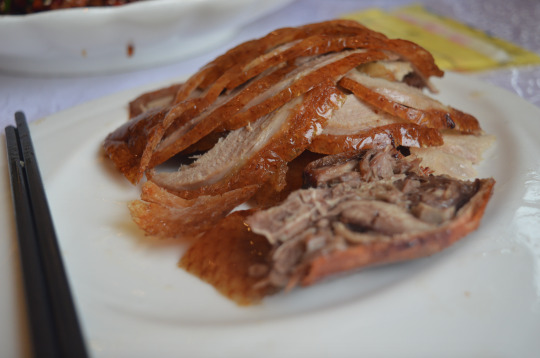
There’s also a restaurant called Bao Bao Ding just near our apartment and they sell really great roast pork and duck with rice. It’s not hard to find and I’ve never found it to be anything other than delicious! James also swears by the spicy duck neck snacks that you can get here but I think they’re still too spicy for me!
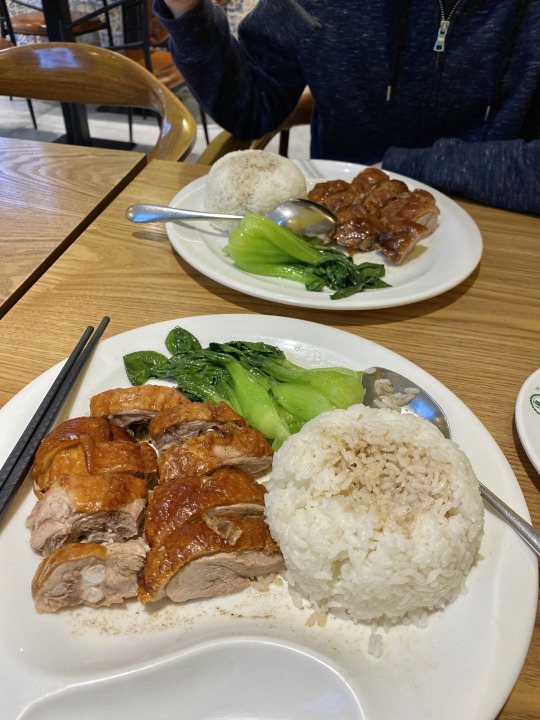
BBQ 烧烤
One of the first restaurants that James and I went to near our new apartment was a BBQ joint just across the street and I fell in love with this area! I’m a big kid and I just love getting involved in cooking the food myself so I really enjoy going for BBQ here. You’re supposed to dip the cooked meat in chopped peanuts and spices when you’ve cooked it on the grill and it’s so good. Unfortunately, I went to a different BBQ joint in the city and ended up getting food poisoning (I don’t think that I cooked the chicken enough) and so I’ve got off BBQ for the moment but I’m sure I’ll be able to get back on it!
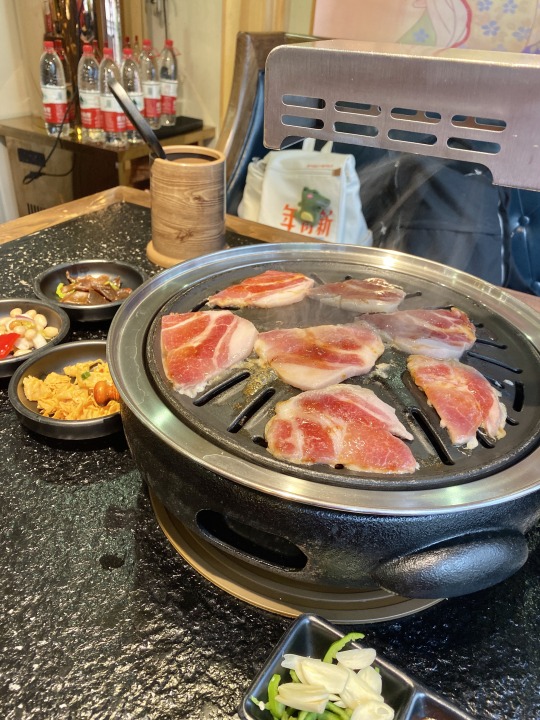
Sweet water noodles 甜水面
I love these noodles so much - they’re always the star of the show. Most famously, you can get them from the Wenshu temple area where there are plenty of vendors selling this street-side snack. They’re quite different to the other noodles in this list because they’re made using a much thicker, square-cut noodle and are served in a sweet-and-spicy sauce. They're served cold and are very chewy with a rough surface to help them grab every bit of the sugary sauce that they're served in. I really love both the chunky look of these noodles and their mouthfeel and I think they’re always going to be something that distinctively reminds me of our wonderful times in Chengdu.

Pastries 蛋糕
Although I do miss a good Greggs sausage roll - Chinese pastries really are off the hook. We live by a bakery called Holiland which opened in the mid 90’s and became the biggest chain bakery in China. I think that’s fantastic news because we won’t have to go without our Holiland fix in Shanghai! Chinese pastries and breads are typically a lot sweeter and lighter than those in the UK and always seem to be much more creative in their presentation - maybe it’s just because they’re new to me but I really find them to be so beautiful. Some of my favourite pastries here are the hotdog pastries (literally just a hotdog in sweet bread) and the half baked cheese (which is sort of like a cheesecake with no base). It’s a very dangerous shop!

Bubble tea 珍珠奶茶
I really love just how readily available bubble tea is everywhere you go here. Every famous western fast food company that’s come over to China has their own bubble tea (McDonalds is the best one) and there are so many other chains (like HeyTeaGo and Fresh One More Time) which sell some really amazing teas. It’s really going to be one of the things I miss the most when we do eventually move back to the UK. One of the best teas you can get is a watermelon tea with a cheese foam topping. There’s a lot of cheese flavoured things here (like cheese flavoured yoghurt) which I’m really into. It’s not so much a hard cheddar cheese and is more like a cream cheese/mascarpone flavouring (if that). I’m really obsessed.
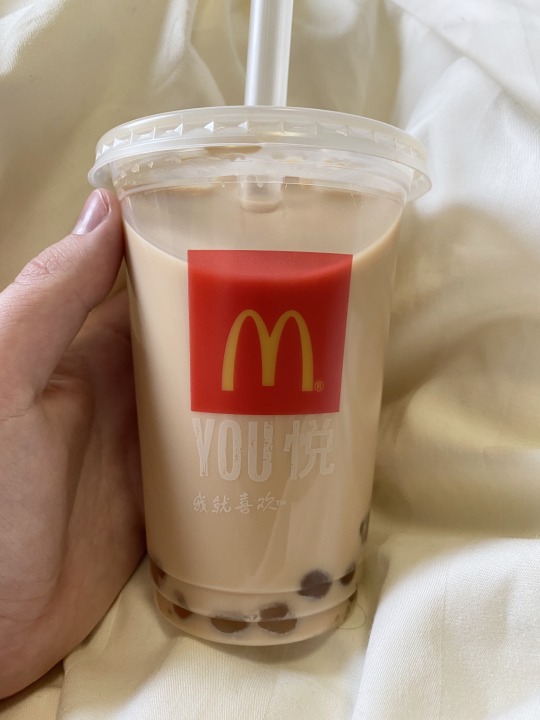
Vegetarian food at temples
I really like visiting temples. I think they’re such beautiful places that offer a calm that you don’t seem to find in many other places in the city. They also often have vegetarian restaurants nearby and the food is super tasty and affordable. When we went to visit the Leshan Buddha with my parents, we went to a restaurant near the temple there and had a lovely meal overlooking the square. I’m just really into these vegetarian restaurants and love what they’re about.

Cake at the kindergarten
We always bake a cake with the little ones whenever its one of their birthdays at the kindergarten. There’s a great mini kitchen downstairs and they’re so precious in the tiny chefs hats and aprons. The cake itself isn’t the most delicious cake I’ve ever had because we don’t put any sugar in it, so it’s more like a bread with fruit on top, but it’s so much fun to share it with so many excited four year olds. It’s great for them to get to bake the cake and then eat it together. I love birthdays at the kindergarten.

Street food 路边小吃
The best part of living in China is the abundance of street food. There have been so many new things I’ve had the opportunity to try from vendors in the road. It also keeps our cost of living down because they’re never that expensive and can be quite filling! I love just picking up some noodles when I’m out and about, or grabbing some Guo Kui 锅魁 (deep fried meat pie) which tastes a little bit like a sausage roll with lots of Szechuan spices.

Liang Gao (Glutinous Rice Curd) 凉糕
Liang gao is a sweet summer dessert which roughly means 'cold cake' (although it's more like cold tofu thing). It's served with sweet molasses and has a texture like jelly pudding but is just mildly sweet without the sauce. I first had it at the noodle shop near our first apartment and it was a great accompaniment to our noodle feast that we had!
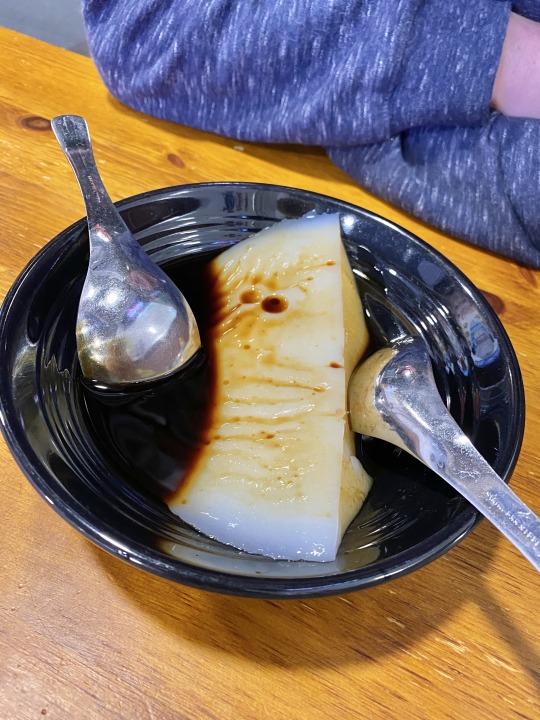
Variety of crisps
China has some really out there crisp flavours. I’m not sure if they’re just novelty or if people really like them but I guess they wouldn’t sell if people weren’t buying them! The most interesting flavours I’ve seen have been lychee sparkling drink flavour and yoghurt drink flavour. Some of the flavours like spicy crab and hotpot flavour are really good but I think I’ll be avoiding the yoghurt for a while longer!

Sugar people 糖人
Sugar people is a form of traditional Chinese folk art using hot liquid sugar to create beautiful shapes and animals. This isn’t really something that is particularly delicious to eat - just because it’s made purely of hardened sugar but it really is beautiful. The reason I love it so much is because I think it’s such an amazing art form and it’s handmade and blown in front of you. I really enjoyed this pig candy because I got to blow it up myself (which a lot of help from the vendor). It’s kind of like glass blowing but you get to eat the finished product (highly recommend not doing this with actual glass).
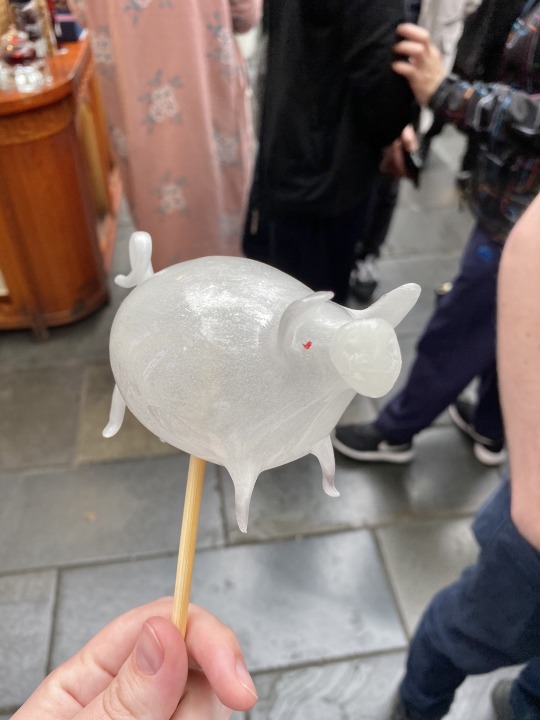
10 notes
·
View notes
Text
Embrace Your Freezer
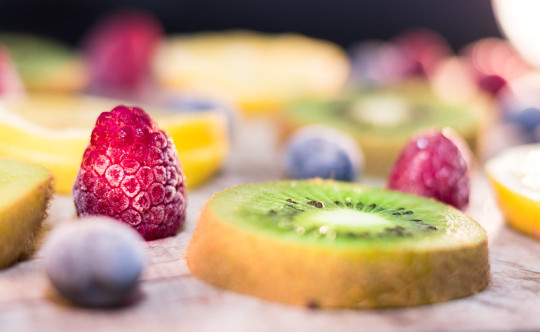
I think you have heard this far too many times – stranger times are afoot. Stockpiling is a particular point of aggression for me, because there is simply no point in buying far more than you need. If supply is an issue, the answer lies in simply utilising the best appliance at your disposal. Yes, I am talking about your freezer.
There is a multitude of food that behaves rather well if you plunge it into the icy-cold depths of your freezer. But, as always, the question of food safety arises. Here is a crash-course into what freezes well, how to fight the devil that is freezer-burn, and what is a freezer-flop and must be avoided at all costs.
Bread
I place this at the top of my list simply because I believe that far too many people have been chucking their Hovis slices into the compost when the slightest bloom of mould appears. Bread is the king of freezer foods. If you buy your bread pre-sliced, you can chuck whatever you believe you cannot finish by the sell-by date into the freezer. If you are a better person than I am, and get those crusty loaves à la Gail’s, make sure to slice them into neat pieces before freezing. Whenever the need for toast arises, no thawing is necessary. Pop it straight into your toaster. You can’t imagine a thing better since frozen bread.
Fruit
Sure, you can buy pre-frozen fruit, and there is nothing wrong in that. But if you think you have far more than you need fresh, you can freeze whatever excess you have. Most fruit freezes remarkably well. And while in some cases (I am looking at you, citrus) the texture does deteriorate, if you are using it for baking/smoothies/juicing – no one would be none the wiser.
A point of note: pitted fruit does best if you remove their stones before the freeze – trying to pry it out with a knife sub-thaw is not much fun. Avoid the peach equivalent to the millennial avocado injury.
Citrus, forgiving my previous dig, is OK if you are using the pulp for a recipe or smoothie – but the zest reigns supreme. Zesting a frozen wedge of citrus fruit is easy peasy. And if you happen to need the flesh of citrus without the skin, just freeze it for whenever you may want to make a casserole calling for that tablespoon of orange zest.
Herbs
We are all culprit to buying a pouch of rosemary when a recipe demands it, and leaving the remainder languishing in the produce drawer. If you have far too many fresh herbs than you know what to do with, freeze them (spoiler alert). Herbs are best if frozen in some kind of fat, so what I do is portion them out in an ice-cube tray, a teaspoon per well, and top each up with a glug of olive oil. If your next pasta sauce demands 2 teaspoons of fresh rosemary – pop out two cubes straight from the tray and toss them into your pan.
Soups and stocks
I am a fan of the Kallo stock cube. But there have been times (i.e. mid-risotto making) when I have had far too much ready than I need. Instead of chucking it away, freeze them in portions (I like to go for a cup per container), so you know exactly how much to thaw out the next time you need it.
Leftovers
I wrote an entire article about leftovers, and it seems particularly prescient to not let whatever you have spare to go to waste. Stews and curries fare particularly well from being frozen – just make sure you portion them according to how much you need for a meal.
Vegetables
The list of vegetables that do well from freezing is far longer than those that do not. Onions, garlic, hard veg (squash, root veg, peppers)…
Spinach and kale, while of the leafier variety, do well if you plan to deploy them later in a cooked dish and not in a salad.
Skin your tomatoes before freezing – by slitting an X at their base, boiling them for 2-3 minutes, then immediately plunging them into a bath of ice-cold water. Their skin will start to shrink back – so peel off whatever remains with languorous ease and pop them into a freezer bag or Tupperware.
While most root vegetables fare well, but potatoes do not. Only waxy potatoes do relatively OK, but I advise this only if you want to use them in some sort of stock, as their texture does change. Just parboil them before freezing.
As a general rule of thumb – veg with a high water content either should not be frozen (i.e. iceberg) or needs some treatment. Hardier veg is much more resilient.
Tofu
Even if food shortage is not an issue, I am a proponent for freezing your tofu.
Baked Goods
Do you know how some people have eyes much bigger than their stomachs? I bake much bigger than my stomach. Most baked goods can be frozen. Banana bread, cinnamon rolls, cookie dough – it’s all good. Just make sure to portion them accordingly for future ease. To bring them back to their former glory – a whirl in the microwave is all you need.
Butter
FREEZE YOUR BUTTER. I use non-dairy butter, but the rule withstands. And, hey, if you happen to be the sort that makes your own shortcrust – pre-frozen butter is a godsend.
Yoghurt and milk
Yes, I am aware that some dairy comes with a warning emblazoned on the side of it – DO NOT FREEZE. But if your intention is to use your dairy in a dish, frozen shouldn’t be a problem. Freezing yoghurt or milk (or non-dairy equivalents) changes the texture of it – no longer silky and velvet but rather (urgh!) lumpy. This resolves itself if you throw it into a biryani or a pasta sauce, but not have any intention of consuming it as you would fresh. Just try you freeze whatever you do not think you can finish as soon as you can – anything a day or so near its sell-by date is risky business.
Eggs
Don’t freeze your eggs in their shells. Crack them open, beat them and portion them in containers labelled with how many eggs lie within them.
Cheese
Hard cheese freezes well, soft cheese less so. If you find a bit of mould growing on your wedge of parmesan, it is completely fine (and safe!) to cut it off with a generous margin, and freeze whatever remains. Soft cheese should not be frozen at all costs – and if you find yourself in the unfortunate circumstance of finding a bit of mould on your mozzarella. Chuck it. It isn’t worth any risk.
Flours
Wheat, rye, spelt, buckwheat, oat… they are the superstar of the freezer. Whenever you need any for a bit of baking, scoop it out and proceed as you would normally.
Nuts and seeds
I grew up in a hot climate, so all of our nuts and seeds claimed residence in our fridge or freezer. Nuts and seeds possess a fat that can, at times, go rancid in warmer temperatures. This poses less of a problem if you buy small bags of the stuff that they sell at Tesco. But, if you are a bulk-buy fiend, pop whatever you think you will not employ in the next few months in the freezer. It will save you a lot of money, and heartache.
Cooked rice, grains and pasta
Yes, you can freeze these. Rice can be tricky, but be sure to cool whatever excess you have ASAP and pop it into the freezer once it is at room temperature. Pasta can be frozen, but please, only if it is just shy of al-dente. You will need to plunge it onto some hot water to revive it, and if it is already slightly over, you will have a soggy, gloppy mess.
Meat
Freezing meat can appear to be a risky endeavour but if you follow a few rules, you’re golden. Freeze it as soon as possible, portioned as you would need per meal. When freezing meat, air is the enemy. Wrap each as much as you can in plastic wrap (or leave it in the vacuum pack it came in) and a further insurance of foil or Tupperware to discourage freezer burn. When thawing (which will be discussed below) – you can either leave it in the refrigerator for a day (smaller portions) or more, or in a tub of slightly-cold water. DO NOT leave it on the countertop, DO NOT microwave it. The 3-month rule applies here for maximum quality, and while a few months shy of that should be okay, the quality of it does deteriorate significantly.
Safe-Freezing Tips
You are now a freezing aficionado. But here are a few final tips about the longevity of frozen food, and just some general freezer-related housekeeping.
How long is it good for? This depends on the food. And while there are a whole list of websites and charts demanding you follow a strict schedule, if you have frozen the food as close to fresh as you can, a lot of it will be OK. But, for the wary, here is a good guide.
How should I freeze? A rule of freezing – minimise air contact. With meat this is crucial, but otherwise, try to use freezer-safe bags or tubs with airtight lids. Label EVERYTHING – with its contents, portions, and date of cooking/freezing. Always try to freeze according to your regular portion size so you can thaw exactly the amount you need.
What should I use to freeze my food? You can buy freezer bags, and containers – but avoid freezing any glass or metal. Glass is particularly tricky as it can shatter (yes, even the freezer-safe ones). Especially if you put anything slightly liquid inside, as water can expand and create cracks your glass container.
How do I thaw my frozen food? You have a few options. You can thaw it in the refrigerator, which is the safest, but also takes a fair amount of time. To speed things up, you can leave it in a bowl of cold water on your countertop, or in the microwave on the defrost setting. Meat, however, should never be let near the microwave in the effort of food safety.
How do I prevent freezer burn? This happens over a period of long freezing, when food loses its water molecules and they rise to the surface and crystallise as ice. Small ice crystals do not pose much of a problem, as they melt fairly quickly. But once larger crystals form, this usually indicates the deterioration of whatever you have had frozen. It is usually still alright to eat this (with the exception of meat and dairy products), but just be prepared for it to be a little subtracted in its original quality.
Image Credit: Theo Crazzolara, Flickr Creative Commons
0 notes
Text
Back to Benavides
By Andrea Dee
When I properly returned to Binondo – to the world’s oldest Chinatown which happens to be in Manila – after approximately ten years, the first place I walked by was a mami and siopao (although I always remembered it for the siomai) restaurant called Masuki, magnetically dragging me to its front step, as charming as always. It struck a familiar chord in me, with regular Sunday breakfast trips to Masuki in my childhood coming up to the front of my mind. Walking around in Binondo just looked different, but maybe that’s because I always used to go to Binondo with my family before. I’ve never really been there alone, so maybe, that’s why I saw the place that way. Maybe it’s because I’ve grown, as well.
Chinatown has grown a lot as well, since its foundation in 1594 and with the establishment of multiple schools and business and with the immigration of many Chinese-Filipinos. Despite the ways Chinatown has grown, though, I’ve heard that Masuki remains exactly the same since its establishment in the 1930s. And to me, it definitely felt like it didn’t change one bit.
See, Masuki and the taste of their chicken mami with its sweet asado sauce never changed over the years and the giant siomai that's as big as my fist reminds me so much of my childhood. The chicken mami, priced at PHP150 for a regular and a PHP160 for a large, had clear soup and plain-tasting noodles with chopped boiled chicken on top, a side of green onions, and a small cup of its signature sauce. You could either pour some sauce over every bite of noodles, or not make use of the sauce in any way - it depends on the person’s preference - but I always liked eating the noodles with the sauce. I think that the sauce is what gives the mami its flavor. However, despite how much I personally liked the mami, I’ve heard people say that they really hate it because the soup supposedly smells bad, but I’ve always had a terrible sense of smell, so it was always just amazing.
Masuki, in all its home-y hole in the wall glory, can be found on the quiet street of Benavides. Benavides is a smaller street one turn away from the busier streets of Ongpin and Salazar, with barely any cars or traffic passing through it, making the street much quieter and more peaceful. Unlike Ongpin street, it is very easy to just walk on Benavides without having to worry about getting hit by a car or running into a tricycle.
Just meters away from Masuki is a Chinese bakery called Wan Kee Bakery Inc. While Wan Kee Bakery isn’t necessarily as big a part of my childhood as Masuki was, it’s part of my life because of its giant siopao. Since I was young, I always liked eating siopao for some unknown reason, and my mom would sometimes bring home siopao – especially the giant siopao – from her trips to Binondo.
The giant siopao first entered my life a few years back when I was twelve or thirteen. My mom brought it home, put it on a plate and compared the size of it to my face for the laughs. I remember even measuring the siopao’s diameter once with a ruler, and if my memory serves me right, the siopao has an approximate eight inch diameter. When you lift the siopao, it feels as heavy as a rock, and it’s filled with pork filling, some veggies and a giant century egg in the middle. It was definitely big enough for four people to share, and even so, it was still extremely filling that it could pass for a whole meal with its thick fluffy bread and the meat inside that was just the right mix of salty and sweet.
So of course, before going back to Binondo, I asked my mom where that giant siopao came from. She told me about the location, what it was called, and that’s how exactly I ended up at Wan Kee Bakery.
It was my first time to ever actually step into Wan Kee Bakery, and some part of me expected it to be a bigger store. (It’s probably because of the size of the siopao.) The entrance didn’t look fancy and honestly, it looked sort of dingy from the outside. If you don’t look around while walking or if you’re not specifically looking for Wan Kee Bakery, you probably won’t be able to spot it. Lucky for me, I was both looking for it and looking around as I walked, so I was about to find it on my first try. But yeah, it didn’t look like how I expected it to look like. In my head I had this image of Wan Kee Bakery having bright yellow lights and even LED lights on top of the entrance, a bigger signage, and a larger space inside. So when I went in the bakery, I was internally surprised and maybe sort of disappointed to see how small and cluttered it was. But it did feel just as homey and smelled just as warm as your typical bakery. One of the workers there was still baking fresh goods in front of their dirty glass window, that anyone passing by could peek in and see the goods being baked in the morning.
The bakery had one corner cluttered with bread boxes and barely enough space for buyers to walk around in. But right when you enter the shop, just less than two meters from the entrance, the first thing you see are freezers where their siopaos are stored. In one freezer are the smaller siopao – bola-bola, monggo, asado, they'll have it. Beside it, in a bigger freezer, are the bigger siopaos. Heh, seeing the giant siopao made me laugh to myself. I even wanted to buy some, but I was worried that I wouldn’t be able to finish it.
Moving on from the siopao, the bakery also has different breads such as rolls of various flavors, cheese breads, donuts, pies, cake, and yes, hopia. And take note, they have five different types of hopia - baboy special, ube, yellow monggo, black monggo, and monggo with peanut. I've never been the biggest fan of hopia, but surely, this may be the store with one of the most varied options of hopia flavors to choose from. However as a fan of donuts and pies and siopao, the egg pies, donuts and smaller siopaos did look especially appetizing. The asado and bola-bola siopaos were fresh out of the steamer and smelled savory and flavorsome. The egg pies looked soft and sweet, and the sugar coating the donuts made it look extremely inviting to my childlike taste buds. Though I unfortunately left the store empty handed because it was a bit crowded when I went in, and I never really liked buying things when the store was still so full. Also, I hadn’t even eaten lunch, and I didn’t want to buy bread and pastries when I haven’t eaten yet.
When I left Wan Kee Bakery with empty hands and walked a little more, I was almost at the end of the road. It was a dead end where you would turn left and go on to the larger and busier streets of Ongpin and Salazar, and already being in Binondo, of course I had to check out Ongpin Street and Salazar Street as well.
But while there’s more life, more hotels, more drugstores, more Chinese restaurants, more merchandise stores and probably much more culture and history on the streets of Ongpin and Salazar, they don’t and didn’t trigger any warmth in me as I walked on those streets. I didn’t spend much time walking around in Ongpin. I only took in the busy crowds, the honking cars and the bad traffic, with my mind unintentionally comparing Ongpin’s hustle and bustle to the stillness and calmness of Benavides.
See, I like the tranquility and sentimental value in the places I go to - which may be why I’m always drawn to Masuki, and always drawn to that giant siopao in Wan Kee. And as far as I know, there is only one Masuki, and only one Wan Kee Bakery in Binondo. That, I feel, is the reason why no other street can really bring back the same warm and fuzzy childhood memories that Benavides Street does, in all its familiarity.
Until now, I can remember how on those Sunday mornings from my childhood, my mom used to give me and my older sister money. She would tell us to go to the small hair salon right across the street to get our hair cut before we would go to Divisoria. These days, my sister and I don't go there as often as before because of our schedules. My mom does occasionally go, though. Sometimes, I have to go with her because the dermatology clinic I go to is in Bambang, near Binondo, and afterwards, she would bring me with her to a Chinese restaurant so she could buy takeout for our lunch. More often than not, she would just leave the house while we're asleep and bring home the food herself.
When I returned to the Binondo area on my own, around ten years after our regular Sunday mornings in Binondo, it was my first time to actually go to Wan Kee Bakery, to Ongpin Street, to Salazar Street - it was the first time for me to actually experience and walk through Binondo alone, without my dad or my mom or my sister. I like to think that it’s different seeing it when you’re a little kid compared to when you’re seeing it now, when you’re old enough to think for yourself and not get lost on the streets all that easily anymore.
Ah, it’s time for lunch.
From Ongpin and Salazar, from the front of the big Chinese drugstore across the dead end where you turn left, I slowly returned to Benavides. Walking back, I took longer looks at the signs over the stores, walking and avoiding the few passing cars until I stopped where a large red-orange gate was open. I walked down the two tiny steps leading into the restaurant and sat at a corner table, smiling to myself upon spotting the exact same table where my family and I used to sit at for our Sunday breakfasts.
Even from a different view, Masuki still looked the same after so many years, with its wooden chairs and tables and checkerboard patterned flooring. The same cashier, the same kitchen, the same bathroom, the same menus. I don’t know if the workers were still the same people from before, but it sure felt so familiar. Staying close to familiarity, I ordered one regular mami, and I ate it the exact same way - picking up a bit of the noodles with my chopsticks and spooning up some sauce and slathering it all over the noodles before eating it. I can still recall how my mom and I would share one large bowl of mami because I was still small, and looking back on it now, it's really heartwarming. These days, I can finish a whole bowl of mami all on my own but the the warmth that comes from eating it is still there.
Despite how Masuki looked exactly the same, the area right outside it was different. Yeah, the bakeries, the trading stores, the other restaurants were still there, but the hair salon we used to go to when we were younger had closed down and was replaced with a garage that seemingly looks like one for a factory.
Ten years really do seem to bring a lot of change to a once-familiar place, huh? But at least, you know in yourself that the feelings that those once-familiar places, such as the warmth Benavides has me feel every time I go there, brought you will never change.
Gallery: https://cnfhumss12a.tumblr.com/tagged/Andrea
0 notes
Text
The Food Eyecatches in Yuri!!! on Ice
So I just noticed that each dish’s name is the in the background of the eyecatches, and I feel silly for not having noticed them before! I’m a huge foodie, so I decided to look into each of the dishes featured during the commercial breaks of the show! Sources, including image sources, are provided at the end of each section.
Episode 1: Pirozhki

Literally meaning “small pies” in Russian, pirozhki (пирожки) are little pies or buns that can either be baked or fried. They can be stuffed with savory fillings, such as meat, fish, vegetables, or potatoes, or sweet fillings, such as fruit, jam, or cottage cheese. They are often glazed with egg to produce its signature golden brown color. The traditional pirozhki we see in the show appear to be filled with beef and possibly cheese. (x) (x)
Episode 2: Katsudon

Katsudon (カツ丼) is a bowl of rice that is topped with deep-fried pork cutlets, egg, vegetables, and other condiments. The name of the dish is a portmanteau of the Japanese words tonkatsu (豚カツ), meaning “pork cutlet,” and donburi (丼), meaning “rice bowl.” There many different variations of katsudon, and the one that we see in the show is the most well-known, called tamago-toji katsudon (卵とじ カツ丼), meaning “egg-bound cutlet bowl.” A modern tradition has developed for students and athletes to eat katsudon the night before a test or sporting event for good luck, or afterwards as a reward, since the Japanese word “katsu” (勝つ) also can mean “to win” or “to be victorious.” (So this is actually not a tradition specific to Yuuri, it’s a Japanese tradition in general.) (x) (x) (x)
Episode 3: Shochu
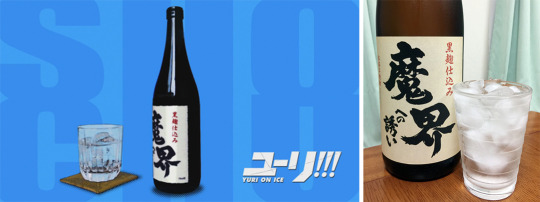
Shochu (焼酎) (not to be confused with the Korean soju [소주] or the Chinese shaojiu [烧酒]) is an alcoholic beverage typically distilled from rice, but it can also be distilled from a variety of sources including barley, sweet potatoes, and buckwheat (soba). It is typically 25% alcohol by volume, which is stronger than wine and sake, but weaker than whiskey and vodka. It originated in the Japanese region of Kyushu, and the particular shochu pictured here is from the Saga prefecture, which is where Karatsu (the inspiration for Hasetsu) is located. It’s called “Makai heno Izanai” (魔界への誘), meaning “Invitation to Makai,” which is where the demons of Japanese folklore live.
This shochu is produced by using black koji and sweet potatoes; black koji is a kind of mold that’s used to break down the starches in the potatoes so that they can start to ferment into alcohol. The kind of koji used greatly affects the final taste of the shochu, and black koji specifically gives shochu a signature strong aroma and a sweet and mellow taste. You can actually buy this exact shochu at Amazon.jp, though there are several countries they will not ship to, including the US. (The page also includes pictures of the distillery and the production process, so it’s worth checking out regardless!) (x) (x) (x) (x)
Episode 4: Ika Sushi

“Ika” (イカ) is Japanese for “squid.” “Ika sushi” is actually an incorrect name for the particular dish pictured here, as sushi means sliced fish over rice. This particular dish is actually called ika no ikizukuri (イカの活造り), meaning “live squid sashimi” (yes, LIVE). It’s also a specialty of Yobuko town in Karatsu, which again is the inspiration for the show’s Hasetsu. It’s made by taking a live squid out of a tank and preparing it immediately, which keeps the squid’s transparent look. Here’s a video of the dish, where you can still see the squid twitching!!!! (x)
Episode 5: Kibi Dango

Kibi dango (吉備団子) are sweet confections made with glutinous rice flour called mochiko (もち米粉) (which is the same flour used to make mochi) and are sometimes filled with a sweet flavored syrup. Three to four dango are usually served on a skewer, and they’re often accompanied by green tea. There are many different kinds of dango, some of which are regional or are made during a specific time of year, like the hanami dango for cherry blossom season.
Kibi dango are from the former Japanese Kibi province, which is where the Okayama prefecture is today (Okayama is where the Chugoku, Shikoku, and Kyushu Championship took place in episode 5). Originally, kibi dango were made from millet, and those are inextricably tied to the Japanese legend of Momotaro (Peach Boy), in which he touts them as the "number one” dango in Japan. Kibi dango confectioners will often tie Momotaro into their marketing so their products have that same positive connotation. Both kibi dango and Momotaro are very important aspects of the cultural heritage of Okayama. The kibi dango pictured here appear to be made with Okinawan purple sweet potatoes and are dusted with kinako (黄粉), which is roasted soy bean flour. (x) (x) (x)
Episode 6: Hinabe


Hinabe (火鍋) is the Japanese word for Chinese hot pot. Hot pot originated in the Chinese province of Sichuan, which is known for its spicy food, as a meal for port workers and fishermen. The idea was to mask poor and unappetizing cuts of meat (including offal, the insides and entrails of an animal) with lots of spices to disguise its low quality, but eventually hot pot became a very popular dish that now uses more fragrant spices and higher quality meat.
Having a hot pot meal is a unique experience (hence why Victor is so excited to go eat it!): Sharing family-style, you poach various raw ingredients--including all different kinds of thinly-sliced meat, seafood, noodles, dumplings, and vegetables--in different kinds of simmering broth (top picture) and then eat them when they’re finished cooking (bottom picture). There are also usually lots of really flavorful dipping sauces to use!
In the eyecatch, the soup on the left is Chinese herbal soup, a non-spicy clear soup made with chicken stock, ginger, scallions, goji berries, and dates. Cooked ingredients pictured here include shiitake mushrooms, spinach, and daikon radishes. The soup on the right is mala soup (麻辣火鍋), whose broth is made with Sichuan peppercorn, chili pepper, spicy bean paste, garlic, and a mix of aromatic spices--it can be so spicy that it can have a numbing effect! Cooked ingredients pictured here include chicken, daikon radishes, and wontons. (x) (x) (x) (x) (x) (x)
Episode 7: Shanghai Gani

“Gani” (蟹) is Japanese for “crab.” Specifically, this is Chinese mitten crab (上海毛蟹), also known as the Shanghai hairy crab, which is named for its furry claws that look like mittens (warning: pic is kind of creepy!). It’s a popular dish to eat in autumn (which is when the Cup of China takes place, hence its appearance here), and it’s a delicacy: It can cost $100 USD for two pounds of crabs! The crab pictured here has been steamed, which is the traditional Shanghainese way of preparing it, and it’s often served with dipping sauce made of rice vinegar, sugar, and ginger. (x) (x) (x)
Episode 8: Borscht

Originating in Ukraine, borscht (Russian: борщ or Yiddish: באָרשט) is a sour soup found in many Eastern European cuisines, and all of them have their own variation of the dish. There are so many different kinds of borscht that it would be difficult to cover them all here, so I’d check out the Wikipedia article if you’re interested. The borscht pictured here most likely includes meat or bone stock, sautéed vegetables, fermented beetroot juice (which provides the signature red color), sour cream (probably an Eastern European kind called smetana), and parsley. (x) (x)
Episode 9: Tsuboyaki

Wow, I cannot even believe how much trouble this one gave me. So from what I can find, it appears that this is a dish that you can really only find in Russian restaurants in Japan. (It’s kind of similar to pasta alfredo in that way, which is a dish that’s really popular in in Italian restaurants in America, but is not a traditional Italian dish, and the only places that you’ll find it in Italy are restaurants that cater to tourists.)
Anyway, so “tsuboyaki” (つぼ焼き) means “pot roast” in Japanese (though it usually refers to sazae no tsuboyaki, which is grilled turban shell), and it’s a Japanese take on Russian cream of mushroom soup that Japanese restaurants call “guribami” (グリバーミ) (”griby” [грибы] is just Russian for “mushrooms”), which you can see in the “after” eyecatch. It sometimes has potatoes or seafood in it, and it has a baked soft bread or puff pastry on top. You can then poke through the bread to eat it with the soup. The closest traditional Russian equivalent I could find is called gorshochke (горшочке), which are usually hearty meat-and-vegetable stews baked in traditional Russian clay pots with lids. The bread on top is optional, but the dough acts like a lid that keeps all of the heat inside the pot, and the bread then absorbs all of the yummy aromas! (x) (x) (x)
Episode 10: Paella

Paella is a saffron rice dish that originated in the Spanish region of Valencia. It’s baked in a traditional pan called a paellera, pictured here. It’s traditionally cooked over an open fire while burning orange tree branches, pine branches, and pine cones to infuse it with an aromatic smoke. Traditional Valencian paella (paella valenciana) usually includes chicken, rabbit, green beans, and other vegetables, but the more well-known take is the seafood paella (paella de marisco) pictured here. This paella includes mussels, shrimp, prawns, and calamari. (x) (x) (x)
Episode 11: Gambas a la Plancha

Gambas a la Plancha is Spanish for “griddled prawns.” The prawns are prepared using a griddle or large frying pan over an open fire, which retains all of the juices from the prawns that would otherwise drip through a regular grill. It’s a simple dish, usually made with olive oil, garlic, parsley, and lemon. They’re commonly served in Spain as tapas, which are small appetizers or snacks. (x) (x)
Episode 12: Pinchos

Pinchos, Spanish for “thorns” or “spikes,” are traditional Northern Spain snacks often eaten in bars or taverns while drinking wine and socializing. They’re an essential part of local culture particularly in the Navarre and Basque regions of Spain (though you’ll usually find them on a skewer in Basque, where they’re called “pintxos”). They’re similar to tapas (and are sometimes just called tapas in some parts of Spain), but pinchos will always have a toothpick or skewer, often attached to a piece of baguette-style bread. Common ingredients in pinchos include cooked or smoked fish, seafood, pickles, cheese, peppers, eggs, and jelly spreads. (x) (x) (x)
If you have any questions, corrections, or additions for any of the dishes or information in this post, please don’t hesitate to PM me!
98 notes
·
View notes